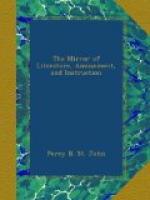The receiver has scarcely been filled, when they pour the brandy warm from it into a large wooden vessel with a spout, from which they fill leather bottles, or gourds.
It is customary for the host, with whom the company is then, to pour brandy into a vessel, and afterwards to throw part of it into the fire, and part towards the hole by which the smoke issues to render the spirits of the air or his tutelary angel propitious. Lastly, the warm brandy circulates among the company, composed of kinsfolk and friends, in large cups, which often do not hold less than a bottle. If a little is left, it is heated again before it is drunk. This milk-brandy, on account of the aqueous parts which it contains, does not inebriate so easily when a small quantity is taken, as brandy made from grain; but it is found, by the example of the Russians and all the tribes of the Steppes, that the drunkenness which it causes continues longer, and entirely destroys the appetite. On the other hand, it does not produce violent head-aches, like corn-brandy.
The rich Kalmucks and Mongols are in the habit, when they pass the winter near towns, of distilling with or without milk brandy from leavened bread. The product, it is said, is stronger, and has a keener taste than milk-brandy. The residuum of the distillation of milk-brandy, which is sharp, and has a smell like wine lees, is applied to various uses. Sometimes it is mixed with fresh milk, and immediately eaten; sometimes it is applied for preparing sheep and lamb skins; sometimes the women boil it, either by itself, or, if it is too sharp, with a mixture of sweet milk, until it thickens, and then pour the cheesy substance into bags, which, when thoroughly dried, they throw into heaps. They also, like the Tartar tribes, frequently form it into round cakes, which they dry in the sun, and keep principally for journeys and for winter use. The residuum of distillation is called bosson, and by the Mongols tsakha.—The cheese formed in heaps is named chourmyk, that in cakes, thorossoun.
They make another kind of cheese also, chiefly of sheep’s and goats’ milk. The fresh milk is put into a kettle with a like sour milk (ederecksen ussun), or some remnant of brandy (bossah). They are well mixed, and then left for some time to sour. Fire is then put under the kettle, and the mixture is stirred while it boils briskly, that the cheesy parts may be converted into a kind of froth (koosoun). When all the aqueous parts of the milk are expelled by boiling, it little butter is added. The whole is again stirred, and left upon the fire until the froth begins to dry and turn brown. It is then ready, and if properly prepared, has an agreeable taste.




